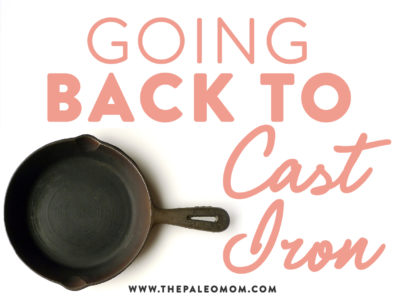When I was a kid, the two most common cooking vessels used in our home were our cast iron frying pan and our wok. But then the low-fat diet revolution came. And suddenly the amount of cooking fat typically used when cooking with cast-iron or stainless-steel was considered a major health risk. So we, like so many families, switched to non-stick pans. Teflon.
Now remember the controversial statements made a few years ago by the EPA regarding the safety of one of the components of Teflon, perfluorooctanoic acid? It is still unclear whether cooking with Teflon-coated cookware will increase your risk of cancer. It seems as though non-stick cookware is safe as long as the cooking temperature is kept fairly low (below 260F) and the coating is intact (throw it out as soon as it starts to scratch or flake). But, other than a few applications where that non-stick coating is magical, why not go back to those old tried-and-true cast-iron and stainless-steel pots and pans? Especially now that we know that fat is not bad for you!
Cooking with cast-iron is great. A well-seasoned pan is just as slippery as its non-stick counterpart. It heats evenly, can go in the oven, can be used at high temperatures, increases the iron content of our food, and has a very, very long lifetime. And while high-end cast-iron cookware costs a pretty penny, a basic cast-iron frying pan is very inexpensive. (see for example, Lodge Logic L10SK3 12-Inch Pre-Seasoned Skillet)
Are you daunted by this whole “seasoning” business? Yes, cast-iron cookware needs to be seasoned. But, this isn’t a hard thing to do. It basically means putting some fat in the pan and heating it in some way. When you do this, the fat polymerizes on the surface of the pan and creates a non-stick coating. You can season your pan with a variety of fats in a variety of ways, and of course, some work better than others. I found a great blog posting on the science of seasoning cast-iron here. While many people use saturated fat to season their pans, Sheryl Canter’s recommendation is to use flax oil (or another ALA-rich oil). Place the pan in your oven and preheat to 200F. Remove the pan from your oven (turn the oven off for now) and coat entirely with oil, inside and out. Then, remove all excess oil with paper towel. Put the pan back in the oven upside down and turn the oven on to 500F. Once the oven has preheated, let the pan “bake” for 1 hour. Turn the oven off and let the pan sit in there until the oven is cool (about 2 hours). Don’t open the door before that point unless you want to fill your kitchen with toxic smoke. With a new pan, repeat this process about six times before your first use. After that, season as needed, anytime the surface starts to look dull or rusty.
Save 80% Off the Foundations of Health
Expand your health knowledge on a wide range of topics relevant to you, from how to evaluate scientific studies, to therapeutic diet and lifestyle, to leaky gut and gut microbiome health, to sustainable weight loss, and much more!!!

Washing your cast-iron pan is easy too as long as you do it while it’s still warm. It’s best to use a gentle scrubber (think a brush or scouring pads instead of steel wool) and hot water. Don’t use dish soap (if some special mess requires dish soap, you will have to season your pan again afterward). If the pan is hard to wash, it probably needs to be seasoned again.
Truly, there are few things in a kitchen as beautiful as the shiny black color of a well-seasoned cast-iron pan. And while, I still use my non-stick pan for some purposes (cooking anything salty, like bacon or sausage, can be pretty rough on a cast-iron frying pan), I feel as though I have discovered a new love: a love of cooking with my cast-iron frying pan.




 Swedish Meatballs
Swedish Meatballs